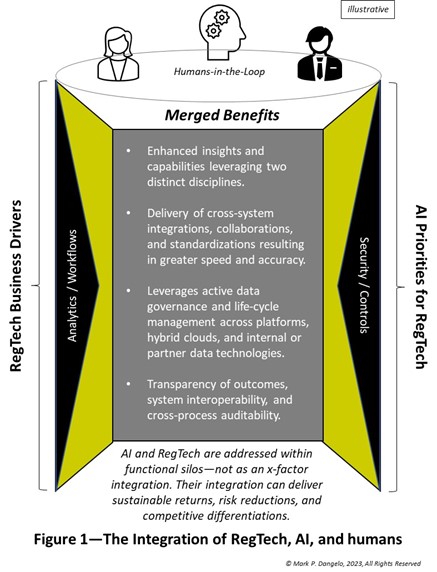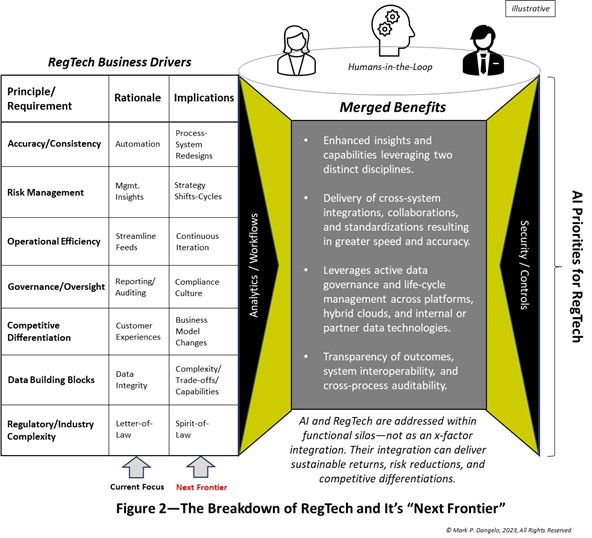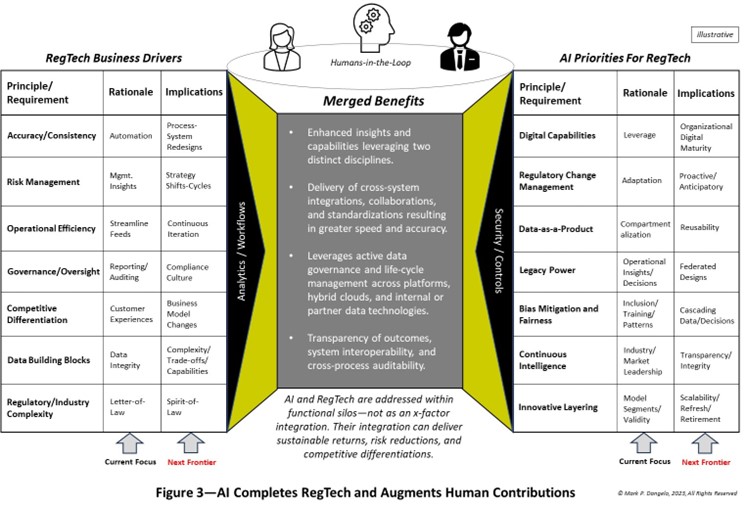AI is all the rage for discussions, industry impacts, and rule-making bodies — yet, to define innovative frameworks for AI-enabled regulatory compliance utilizing traditional rules-design thinking may create additional costs and complexities for industries hoping for less burdens, more insights, and greater cost-efficiencies
In this two-part blog series, we look at the evolving state of artificial intelligence-enabled regulatory compliance and how they can be sustainably implemented
As innovation is measured across history, the embrace and capabilities of artificial intelligence (AI) is nothing short of a quantum shift — one that’s exploded over the last 18 months. Moreover, the foundations for AI’s value proposition, business cases, and even applicability to industry-defined regulatory compliance are advancing weekly, and all underpinned by decades of rule-defined computer science trial-and-error solutions.
Traditionally, regulatory compliance represents a set of rules — a set of knowns that are the result of careful designs, comment periods, and data reporting. It is often considered to be about designing the future using the mold of historical transactions and targeted demographics to ensure controls and risks are within acceptable guidelines. However, will the history, the training data, or even the expert trends identified be enough to mold AI responsibly within and across existing operational capabilities?
Asking different questions
While AI stirs the imagination of what is possible in leveraging human experiential skills, it also fundamentally black boxes much of the traditional balance and controls, which were common in prior computing generational designs. Indeed, AI will likely displace workers whose purpose was to gather, align, and report against governance criteria after-the-fact, and it will transform their to-be purpose into anticipating outcomes and identifying improvements in their new role as humans within the AI loop.
And just as workers seek to have greater control over their jobs and duties, AI and its supercharging of traditional regulatory technology (regtech), will alter the purpose of their assigned roles and responsibilities.
As regtech undergoes a quantum phase shift itself — augmenting with AI and incorporating humans in the loop — what does that mean for processes, technologies, and the individuals involved? What are the advantages that are achieved beyond the traditional silos of functional solutions? And how will this impact consumers, businesses, and above all, regulators?
To help us decipher this, let’s explore a new, conceptual model (see Figure 1), which foundationally leverages the components of all three segments — regtech, AI, and humans — to integrate sustainable value-added benefits.

While the organizational temptation is to start with AI capabilities and then bolt them into existing or planned regtech capabilities, the most sustainable results are when AI’s integration is holistically addressed, including the implications of adoption.
Further, this merging of three traditional silos enhances natively digital compliance designs underpinned by robust, intelligence-driven corporate governance that utilizes advanced digital maturity capabilities. And this compares more favorably than current compliance designs that originally represented the digital automation of paper-based forms and discrete, prescriptive rules.
Is there a revenue opportunity through design?
A critical, differentiating outcome might come as a surprise for some individuals and organizations that may be skilled in the traditional silos of regtech and AI. After all, can their proactive, interconnected design with humans yield new revenue opportunities? What areas should be targeted? How will the enterprise mitigate the weaknesses within the program’s triple constraints, while delivering progressive results? And, critically, who will be accountable for the design, the outcomes, and the on-going business and technical iterations?
To address these questions and then to prepare action items that deliver desired key performance indicators (KPIs), we need to breakdown the regtech business drivers and their implications of adoption (see Figure 2).

What becomes apparent when reviewing this subset of business drivers, is the traditional foci concentrate on the principles of solutions and the rationale of the methods used for implementing. Additionally, often assumed or ignored are the implications of adoption that address sustainability and adaptability of the initial investments. The implications represent the Next Frontier of capabilities needed to further the original ideas as the rise of intelligent models and algorithms become codified in open-source models and even within emerging hardware chipset designs. But is that all?
Upon further examination of Figure 2, it is the Implications that present the greatest challenges — and opportunities — when it comes to incorporating advancing AI functionality into legacy and future operations. Indeed, that becomes apparent when we explore the AI priorities for regtech and examine the implications of these principles.

What is illustrated in Figure 3 is the representative landscape or ecosystem of drivers and priorities that push forth corporate initiatives. And when analyzed separately, these continue to define the embryonic implementation methods used for early-stage adoption since 2018.
However, when the intersection of these distinct disciplines is analyzed across industries to leverage fragmented technology investments, new opportunities can be extracted for uncommon revenue growth — such as inclusion, underserved customer markets, rapid decision cycles, and competitive advantages — all far beyond the Current Focus which is driven by efficiencies and desire for scale.
Figure 3 also represents the conceptual integration, operating efficiencies, and revenue potentials that is possible when enterprises create a strategy for interoperability demanded by AI-enabled regtech. Whereas the individual industry nuances and regulatory bodies will directly influence the granular data-driven and infrastructure designs, the aforementioned drivers and priorities represent consistent requirements surrounding the outsized measures of auditability, transparency, continuous adaptability, customer behaviors, and of course revenue and efficiency performance management.
What designs work the best?
As we have illustrated, the multi-faceted and cascading demands and impacts of integrating regtech, AI, and human skills is an important, yet evolving, approach to leveraging vast data quantities and data-decision capabilities. While Figure 3 showcases several fundamental business drivers, it also identifies complex touchpoints and data-leverage demands that are currently not traditional core competencies within enterprises, nor with their vendors and outsourcing partners.
Clearly, AI is in its gold-rush or fear of missing out (FOMO) phase, pushing corporate adoption ahead, even without a firm understanding of downstream consequences. Further, many enterprise leaders seek to push forward with AI solutions without a baseline of where it fits, what operational skills are needed, or whether a strategy for uncovering the hidden benefits has been identified. To avoid repeating the mistakes of others, enterprises should address the business foundation needed for not just implementation, but for sustainable actions and corresponding solutions.







